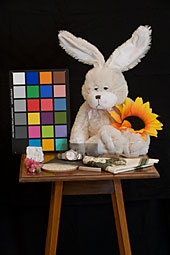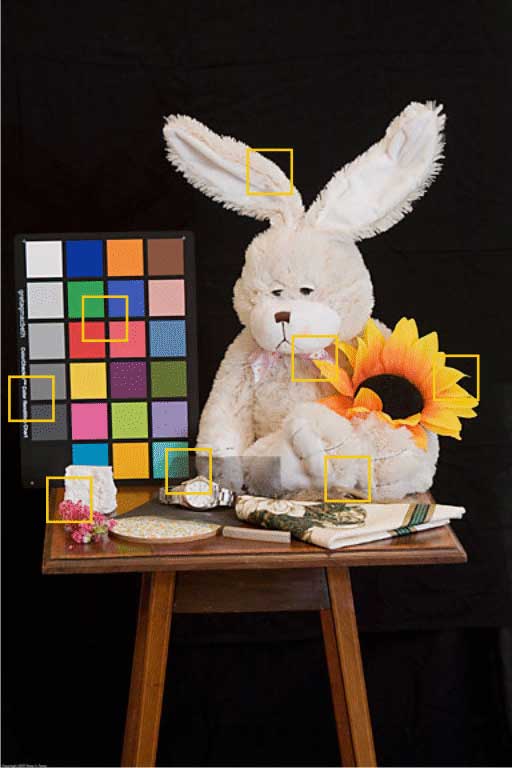Note that the top ISO speed on the 5D (3200) and the top two on the D3 (12,800 & 25,600) are not 'real' speeds. The camera exposes at its true top speed and then stretches the resulting DNs in firmware.

This is the most photographic, rather than technical, test that I did on the D3. Before we go on, I have to make a confession...
I fluffed this test. I did these tests with a tripod and I wanted to use mirror lock up and the self timer because I did not have a remote or cable release for the D3. Unfortunately, it is impossible on the D3 to use mirror lock up and the self timer at the same time. This is because they are both selected by the same rotary knob. So I just used the self timer and forgot about mirror lock up.
Most regrettably, I discovered only afterwards that this has caused some vibration and hence blurring of the pictures taken at lower ISOs and hence longer shutter speeds.
The lesson is: I should have used flash for this test. I'll add a studio flash kit to my Christmas list. Meanwhile, this test is still good for showing colour rendition and how noise looks at different ISOs, and detail resolution at high ISOs.
I set up a still life containing a floppy rabbit, a Gretag Macbeth color checker chart and various other things. I photographed it with the Nikon D3 and the Canon EOS 5D at various ISO settings, using aperture priority exposure. Matrix metering was set for the Nikon, and centre-weighted averaging for the Canon.
The lighting was a combination of overhead tungsten and blue photofloods from the front right. The Nikon was set on automatic white balance but, due to a mistake, the Canon was set on a custom white balance left over from an earlier shoot. Consequently, I had to adjust the white balance of the Canon photos later.
I loaded the raw files into Adobe Lightroom and developed them using a subset of the methods I would normally use for developing ordinary, non-technical pictures. I then compared them at 100% in Photoshop.
For development, I left the exposure, blacks, brightness, contrast, clarity, vibrance, saturation and tone curve at their default settings. The point curve was left at medium contrast. I adjusted recovery to remove any blown highlights, except in specular reflections. I also increased the recovery slightly more, if I felt that this improved the detail in the rabbit's ears. I increased the fill light to remove any blocked shadows from the black parts of the Gretag Macbeth color checker chart, but otherwise allowed blocked shadows to remain in the background.
Luminance and color noise reduction were set to zero. The color noise reduction was then increased until obvious chroma noise was removed from the Gretag Macbeth patches. Then the luminance noise reduction was increased until it did not seem to be making any further improvement.
I set the sharpening to amount 100, radius 1, detail 25 and adjusted masking so that the patches of the Gretag Macbeth chart were not being sharpened. Occasionally, for the top ISO speeds, I reduced the sharpening below 100 where I felt it was not being helpful.
Generally speaking, I tried to develop each photo, within the above constraints, to produce the best result. Of course, my judgement is subjective.
Each camera was tripod mounted and fitted with the manufacturer's professional grade 70-200mm f/2.8 lens with image stabilisation (turned off). The focal length was set at 105mm and the aperture to f/11. Autofocus was used on the rabbit's paw (the one beneath its nose) and focus was then switched to manual for the shots.
I have made some 100% crops later, but you can click on any of the thumbnails below to see a full sized 90-quality jpeg (warning: these are 3 to 6 MB in size, the larger sizes being caused by increased noise at the higher ISOs). (Try widening your browser window if you can't see six rabbits on the next line)
Note that the top ISO speed on the 5D (3200) and the top two on the D3 (12,800 & 25,600) are not 'real' speeds. The camera exposes at its true top speed and then stretches the resulting DNs in firmware.
I think the 5D is focussed slightly further forward (nearer the camera) than the D3: this can be seen if you look at the green and cream napkin at front right of the picture. I'm sorry about that but as I have astigmatism I have to rely on the camera to do the focussing. In so far as either camera has focussed imperfectly, one can note that the Nikon, being a top of the range professional camera, has the ability for the user to preprogram fine adjustments to the focus of each lens (the 5D does not, but the mark III Canon 1D's do).
Click on some of the yellow rectangles below to see the relevant crop:

I say "click on some of the yellow rectangles" because I got demoralised after a while and gave up making the crops. They are of limited value given my problem with vibration at the lower ISOs.
I think the D3 clearly outclasses my Canon EOS 5D at ISO 3200, in terms of more detail and less noise. It may even be that the D3 at ISO 3200 is better than the 5D at 1600. The D3's ISO 12,800 and 25,600 speeds look pretty awful if you pixel peep. But the overall images are perfectly useable. It may also be that more specialised noise reduction programs than Adobe Lightroom could make more of these top speeds.
Peter Facey, Winchester, England
20080123 originated